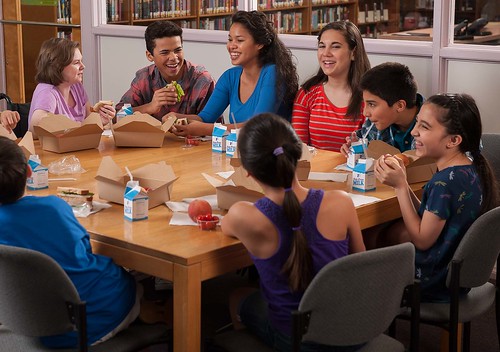
March is National Nutrition Month. Throughout the month, USDA will be highlighting results of our efforts to improve access to safe, healthy food for all Americans and supporting the health of our next generation. We could not have done this work without the support of our partners. Below is a story from one of our partners, Share Our Strength, about a pilot conducted through our Child and Adult-care Food Program, or CACFP. Through CACFP, schools can offer one meal and/or one snack in a congregate meal setting as part of enrichment programs offered outside of regular school hours.
By Wendy Bolger, Director of Program Innovation Strategy, No Kid Hungry
“Any time we can feed an additional kid, even just one, that’s a win!”
Who doesn’t need an energy boost around 3pm? Kids may be out of school by 3pm, but their day is far from done. Most kids have a full afternoon of sports, activities, and homework to do, and to be successful, growing bodies and child-sized tummies require a nutritional boost.
According to KidsHealth from the Nemours Center for Children's Health Media, healthy snacks can be important to managing kids’ hunger and boosting their nutrition.
But for families at risk of hunger, providing a snack for their kids might not be economically possible. Dinner in a struggling household might be served late—after a parent’s long commute, or a late shift.
Afterschool programs that participate in the Child and Adult Care Food Program (CACFP) can provide much-needed healthy meals and snacks to kids and teens. An innovative model piloted by the No Kid Hungry campaign, a national effort to end childhood hunger in America, shows that a free afterschool meal through CACFP can be a part of a healthy day for 50 percent more of the students who qualify when it is promoted to all students, whether or not they participate in traditional afterschool programs.
With support from Tyson Foods, we conducted tests in 20 schools in Alabama, Maryland, Miami, Virginia, South Carolina, Texas, Florida, Illinois, and California. By making an afterschool meal available to all the kids in the school - not only the kids signed up for specific afterschool programs - No Kid Hungry found an average 50 percent participation increase over the historical number of kids served. Afterschool meals and an enrichment opportunity for those not in existing after school programming were promoted to all, so that athletes and those in clubs or plays ate alongside their friends, who may not be in an activity.
Even in schools offering afterschool meals for the first time, our data demonstrated that opening up meals to all kids increased participation 50 percent over what just serving kids enrolled in activities might achieve.
What did the schools say was most valuable about the new open model?
“The freedom for the children who aren’t in the afterschool program to come and eat.”
“In the past they weren’t part of a program, so they went home hungry. Now they know they can come to the dining room and not go home hungry.”
What about discipline problems with kids not enrolled in enrichment or sports?
“The high school students are glad to get fed, so they behave.”
And stigma?
“When the entire football team is carrying those snacks around, it becomes cool right away!”
At No Kid Hungry, we are working hard to break down the barriers between hungry kids and the healthy meals they need. We’ll continue to innovate to connect more kids to CACFP and the other federal nutrition programs, which we know are our best routes to ending childhood hunger in America.
